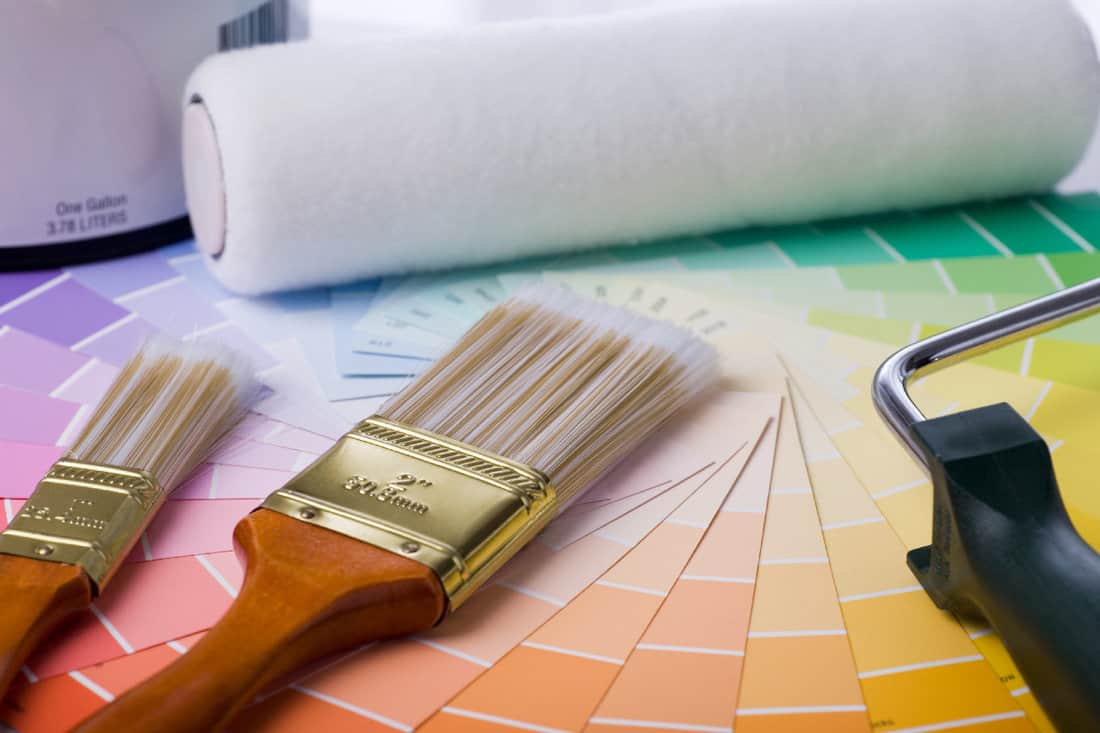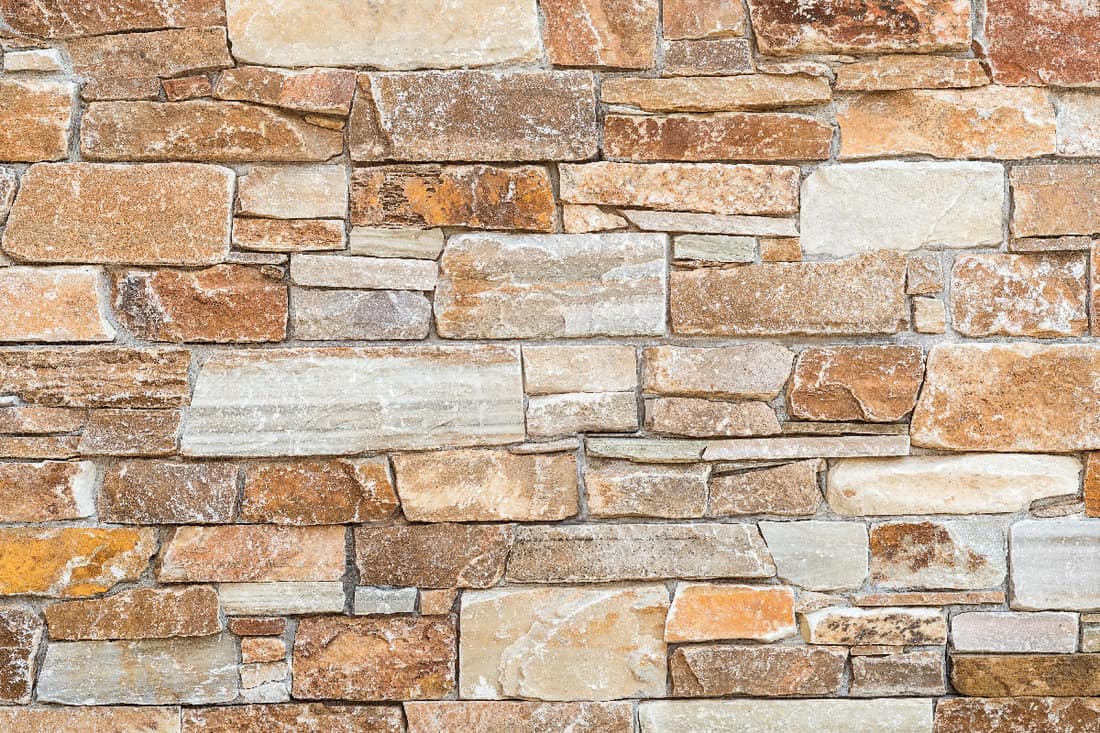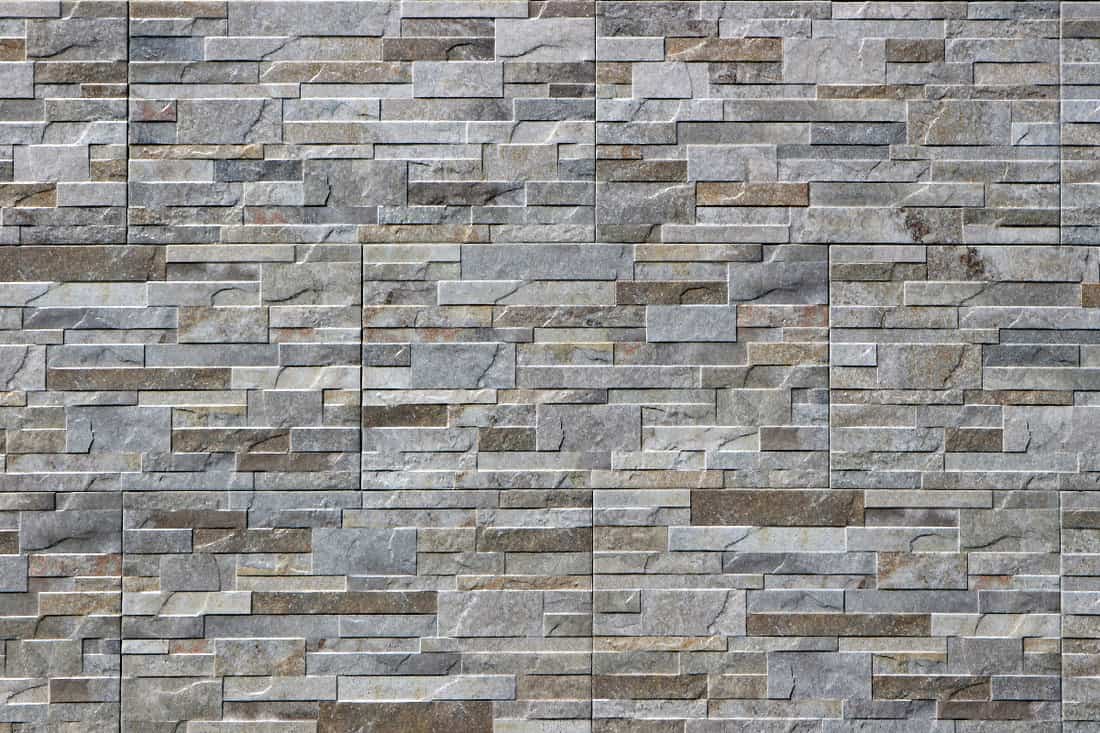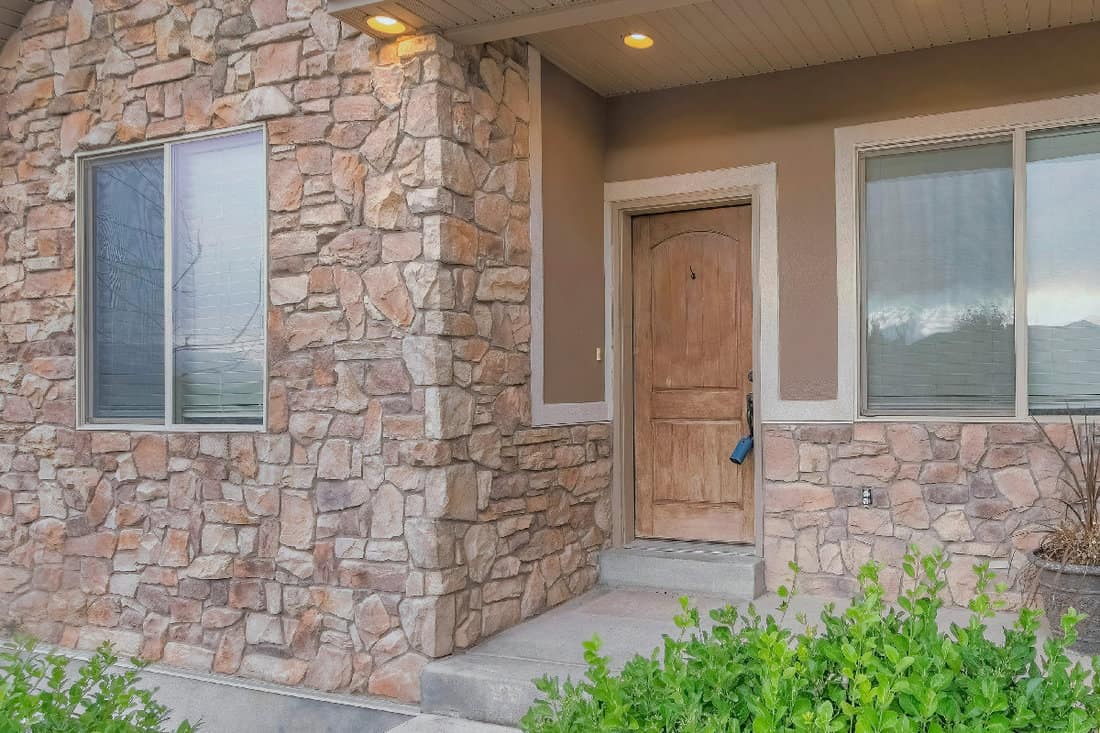Finding new ways to restore the structures around your home isn't always easy. Do you have an aging stone veneer you want to paint over but have no idea if this is possible? Is it a good idea to apply paint to a stone veneer surface? Will this look good?
Luckily, we've done some research and have these answers for you! Let's begin:
Yes, you can generally paint over stone veneer as long as you properly prime it. Specifically, you want to use satin latex paint once you prime your stone veneer surface, as this formula works the best.
You might need to apply two coats of paint over stone veneer to hide the colors underneath, so once your first dries assess the color's coverage.
As we begin this article, we will cover all things painting stone veneer and offer other insight. Whether you're doing a small DIY project, want to remodel on a budget, or have additional questions, we're here to assist! With that said, let's dive right in!
![Facade of a house with brown stone veneer exterior and shrubs at the front, Can You Paint Stone Veneer? [Everything You Need To Know]](https://homedecorbliss.com/wp-content/uploads/2022/11/Can-You-Paint-Stone-Veneer-Everything-You-Need-To-Know.jpg)
Should I Paint Over Stone Veneer?
Painting over your stone veneer will depend on how it's made and what the manufacturer recommends. Although you should be able to do this most times, not all stone veneer is a good candidate for repainting.
We sometimes add affiliate links and content that was curated and created by our team with the help of advanced ai tools to help showcase the best design styles.

According to Evolve Stone, if your veneer is cementitious, you shouldn't try and use paint on it. That's because the cement won't likely take the paint nicely, giving your stone veneer a low-budget feeling.
Since your veneer is already mimicking stone, you don't always want to try and cover it again.
Furthermore, the stone veneer might already be painted to look like natural stone, so if you want to repaint it, try and match the original color as closely as possible.
You will also need to choose a high-quality, satin latex formula, so keep all this in mind. It's better to be overprepared for a project than not ready enough.
Can You Change The Color Of Stone Veneer?
Yes! If you aren't feeling your current stone veneer color, you can certainly change it. As we said, you'll do this by painting over it, although not every veneer surface is the same.
Sometimes, the original color of your veneer is the one it will have forever, so there's not always a need to cover it with a new color/shade.
However, if your stone veneer surface fades, becomes damaged, or your style changes, using a new color should be fine. The key here is priming your veneer, which will make or break your project.
Regardless of your stone veneer's current hue, you must apply a primer. You may even need a few coats. If you're worried about the old color seeping through, use a white cement-friendly formula.
Again, not all stone veneer is the same material, but most times, it will be cement or a similar mixture.
What Is Stone Veneer Made Of?
Stone veneer is generally made using Portland cement, lightweight natural aggregates, and iron oxide pigment for coloration.
This cost-effective alternative to installing genuine stones is popular for indoor and outdoor spaces. Therefore, you should be able to enjoy stone veneer inside or out (as long as it's made well).
Initially, back in the 19th century, this type of faux stone was made using real stones, so that's a bit of history for you. However, now, your stone veneer will not be stone material.
The main draw of having stone veneer is that it resembles actual, genuine stonework while being lighter and cheaper. Think of it as a thin layer of decorative stone over an existing wall/surface.
It's also fairly common to see stone veneer at resorts in common areas or even at the pool, so it pops up more than you'd think.
Is Stone Veneer Real Stone?
Depending on who makes your stone veneer, there is a chance it will have some genuine stone in its material. However, this won't be nearly as durable as true stonework, and your veneer wall won't handle heavy loads.
As we said above, the main point of having a stone veneer is decoration.
Therefore, even one made using a genuine stone mixture can't be treated the same. According to Stone Centers, natural stone veneer is created from real, quarried stone.
From there, this quarried stone is cut into thin pieces, or how you need it to fit your design. Again, that does not make your veneer much stronger than a cement version, so regardless, you need to be cautious.
One of the most common mistakes people make with stone veneer is treating it like the real thing. So, we don't recommend hammering into it, having heavy furniture on it, or being overly rough around it.
How Do You Paint Stone Veneer?
Now that you understand how a stone veneer works, it's time to paint it. Generally, you want to start by coating your entire veneer surface with a latex primer.
Use a roller frame, nap roller cover, and extension pole. Next, allow your primed stone veneer to dry for around two hours before adding paint.

Once that timeframe passes, you can apply your high-quality satin latex paint to the stone veneer surface. As we covered, it's possible to need more than one coat of paint, so keep that in mind.
We recommend waiting a few hours between paint coats to ensure your veneer surface absorbs the paint correctly. You can also take this time to assess what areas of your veneer need more color and which don't, so patience is essential.
Luckily, concrete should dry pretty fast, but this can vary.
Custom BLDG Products CP1 Latex Primer
This product works for various surfaces, has excellent adhesion, seals porous surfaces, covers between 300 and 500 square feet, will go on grey, and comes in a one-gallon container.
Valspar Medallion 100% Acrylic Interior Latex Satin Paint
This interior satin paint is 100% acrylic, works indoors, can go on various surfaces, lasts long, and comes in a five-gallon container.
View this paint on Amazon here.
Can You Stain Stone Veneer?

Yes. If you don't want to paint stone veneer, you can also choose to stain it. Generally, you want to stain exterior stone veneer surfaces, as they will fade faster than indoors.
Furthermore, using a stain on your veneer is a great way to bring it back to its glory without priming, painting, and waiting. According to experts, you want to use a bristle brush to apply your stain.
Unlike painting, you don't need to apply a primer or get intricate with your brush selection, so this idea is perfect for large-scale projects.
In addition, every stain will have a different dry time, which can heavily depend on the temperature. For example, it's usually best to stain exterior walls/surfaces on a bright, cool day, so the product can set.
If it's too hot or rainy, your stain may not adhere properly, and you'll need to do it again. So, check the weather forecast before getting started!
Which Is Better: Staining Or Painting Stone Veneer?
Between painting and staining stone veneer, this depends on your end goal. Generally, painting stone veneer is better for fixing imperfections or stylistic changes.
On the other hand, staining stone veneer can enhance its natural beauty, which your paint will cover.
So, for a historic home or one you want to have a more aged look, we recommend staining. Furthermore, using a stain on your veneer surface is much easier than painting.
Remember, you must prime and prepare a stone veneer surface before painting it, which can take multiple hours of waiting.
On top of that, not every stone veneer surface will take paint. So this can also become an issue if you ignore the manufacturer's recommendation.
How Long Does Stone Veneer Last?

On average, you can expect stone veneer to last between 20 and 75 years. Since your veneer is made using durable cement and natural aggregates, you should see it last quite a while.
Of course, your product will come with an expected lifespan. The best way to figure this out is by reaching out to your stone veneer installer/maker and seeing what they think.
According to First American Roofing, stone veneer is as beautiful and sturdy as the natural rock it emulates. So, even though it's cheaper, your veneer structure should hold out for decades.
Regardless, remember to take proper care of stone veneer and avoid placing extreme weight on it. Doing this can result in cracking or structural damage, hence shortening its lifespan.
How Often Should I Paint My Stone Veneer?
Since stone veneer is made to be low maintenance, you shouldn't need to repaint. However, this can significantly vary on the quality of your product.
As we mentioned earlier, stone veneer is typically better on its own as it ages. Adding a layer of paint can cause your surface to look cheap or, in the worst case, look worse than when you started.
Therefore, we recommend occasional cleaning and possibly staining, while paint should be reserved for covering actual damage or stylistic changes.

To Finish Things Up
Whether you have a stone veneer or want to install it, you need to understand the material. We found that you can usually paint stone veneer as long as it's with high-quality satin latex paint.
Additionally, you want to ensure you use a latex primer for your veneer, as this will prepare it for the best paint adhesion possible. If you don't prep a stone veneer surface properly, expect problems to happen.
Lastly, the stone veneer also responds well to staining, especially if you want to enhance its current color!
Made it this far? Why not check out these additional related home articles below?
13 Wallpaper Patterns That Look Just Like Stone Walls
Is Stone Veneer Worth It? Stone Interior Walls Pros And Cons


